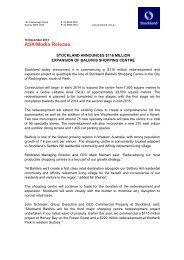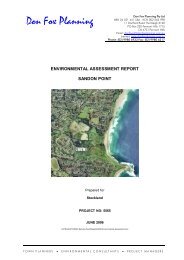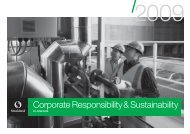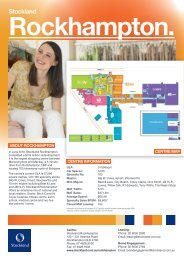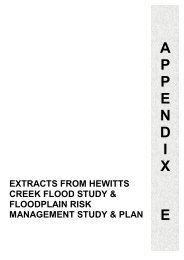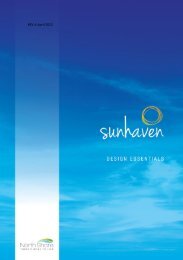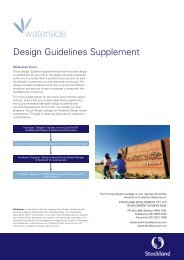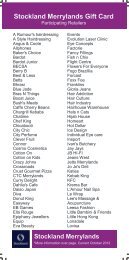Download PDF - Stockland
Download PDF - Stockland
Download PDF - Stockland
Create successful ePaper yourself
Turn your PDF publications into a flip-book with our unique Google optimized e-Paper software.
Employee turnover<br />
During the reporting period, employee<br />
departures categorised as regretted<br />
turnover decreased to 7.5 per cent<br />
(against our target of 10 per cent), which<br />
is an improvement from 12.4 per cent in<br />
FY09. Last year the strong correlation<br />
between employee wellbeing and intention<br />
to stay was acknowledged, and as a<br />
result our training programs have focused<br />
on improving employee wellbeing.<br />
For example, our ‘Inspiring Manager’<br />
series and ‘Leading with Insight’ programs<br />
are designed to support managers in<br />
developing the necessary skills to more<br />
effectively lead their teams. While these<br />
and other initiatives may have assisted<br />
in the reduction of regretted turnover,<br />
economic uncertainty has also been<br />
a factor in improved retention.<br />
To obtain feedback from our employees<br />
at each stage of the working lifecycle we<br />
have put in place a number of initiatives.<br />
Feedback is sought from new employees<br />
within the first three months of their<br />
employment, existing employees via<br />
the ‘Our Voice’ survey, and departing<br />
employees through exit interviews. We<br />
will continue to use information from these<br />
surveys to help our managers lead their<br />
teams and maximise employee retention.<br />
All <strong>Stockland</strong> employees are engaged<br />
under individual employment contracts,<br />
rather than via collective agreements.<br />
If significant operational or structural<br />
changes are required in the business, we<br />
consult with employees impacted by the<br />
changes. Our Redundancy Policy outlines<br />
our approach to restructuring, notification,<br />
redeployment and redundancy.<br />
We remain committed to aligning our<br />
behaviours with our values. Our Code of<br />
Conduct and Ethical Behaviour sets out<br />
the standards of behaviour with which all<br />
our employees are expected to comply.<br />
When people are made an offer to join<br />
<strong>Stockland</strong>, they are required to review the<br />
Code and sign and return the form. The<br />
code references our Fraud and Corruption<br />
Policy, with additional information available<br />
on StockXchange, our intranet. While<br />
we don’t provide specific training on<br />
the Code of Conduct, our compliance<br />
training programs do build employee<br />
awareness on key areas forming part of<br />
the code. For example, our Group Risk<br />
team nominates people in ‘specific roles’<br />
who must undertake an online course<br />
in Trade Practices (including consumer<br />
protection and unfair business conduct<br />
and anti-competitive conduct).<br />
All employees complete online compliance<br />
training in Equal Employment Opportunity<br />
and Privacy, which are areas referred<br />
to in our Code of Conduct and Ethical<br />
Behaviour. Employees must undertake<br />
this online compliance training every<br />
18 months. In FY10, the employment<br />
of five people was terminated due to<br />
breaches of this code.<br />
Our total turnover has decreased<br />
considerably to 14.7 per cent (down from<br />
30.8 per cent last year), which is primarily<br />
due to limited organisational restructuring,<br />
in comparison to the 13 per cent 1<br />
reduction made to our workforce last year.<br />
¹ This reduction includes both the Australian and<br />
UK workforce.<br />
Turnover<br />
End of year turnover<br />
Rolling turnover (%)<br />
FY10 FY09 FY08<br />
Regretted 7.5 12.4 13.3<br />
Non-regretted/<strong>Stockland</strong> initiated 7.2 18.4 13.1<br />
Total 14.7 30.8 26.4<br />
Headcount used is based on end of financial year data. All data (including headcount) excludes those employed on a casual or fixed term basis.<br />
Overall turnover<br />
FY10 FY09 FY08<br />
No. exits 178 369 359<br />
Headcount 1,215 1,236 1,362<br />
Turnover rate 14.7%* 29.9% 26.4%<br />
Headcount used is based on end of financial year data. All data (including headcount) excludes those employed on a casual or fixed term basis.<br />
Turnover – gender<br />
Men<br />
FY10<br />
Women<br />
FY10<br />
Men<br />
FY09<br />
Women<br />
FY09<br />
Men<br />
FY08<br />
Women<br />
FY08<br />
No. exits 89 89 166 203 172 187<br />
Headcount 579 636 644 649 665 697<br />
Turnover rate 15% 14% 26% 31% 26% 27%<br />
Headcount used is based on end of financial year data. All data (including headcount) excludes those employed on a casual or fixed term basis.<br />
Turnover – age group<br />
60 Total<br />
No. exits FY10 48 67 44 15 4 178<br />
No. exits FY09 99 153 79 34 4 369<br />
No. exits FY08 89 141 87 31 11 359<br />
Headcount FY10 331 488 245 120 31 1215<br />
Headcount FY09 346 477 234 115 26 1236<br />
Headcount FY08 395 564 246 132 25 1362<br />
Turnover rate FY10 15% 14% 18% 13% 13% 15%<br />
Turnover rate FY09 29% 32% 34% 30% 15% 30%<br />
Turnover rate FY08 23% 25% 35% 23% 44% 26%<br />
Headcount used is based on end of financial year data. All data (including headcount) excludes those employed on a casual or fixed term basis.<br />
<strong>Stockland</strong> Corporate Responsibility & Sustainability Report June 2010<br />
43



